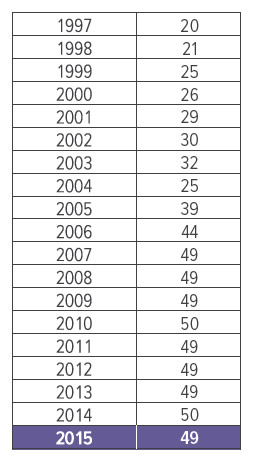2015 IN REVIEW
The Authority’s Strategic Plan, which was written in collaboration with the Authority’s Board of Directors, is based on five pillars, or Strategic Directions, that were created to shape the plans, priorities and future of the Authority over its timeline. This document will discuss the progress of many of the key projects in the Plan and report on the status of longer term projects.
TO GROW STRATEGICALLY
Non-aeronautical revenue generation continues to be an important factor in an airport’s ability to keep aeronautical fees lower, which in turn can help grow air service. Land development, parking revenue, commercial rent and advertising agreements all enhance the airport’s core business and help lead economic development in the region. Planning for airport expansion at the right time and the right cost are critical for the long term success of both the airport and the community.
The following projects contributed to airport growth in 2015:
Commercial Development
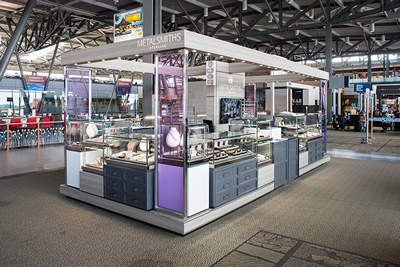
There were some exciting changes in the airport’s commercial space, including the addition of several innovative stores and food and beverage outlets.
In February, Canadian jewelry retailers, Metalsmiths Sterling opened a permanent kiosk in the domestic holdroom by gate 16, to great reviews from our customers. The UK-inspired luxury brand of sterling jewelry offers more than 30 exclusive collections and over 800 pieces for our clients’ shopping pleasure.

The Scoreboard apparel and accessory store opened on June 3rd in the domestic holdroom near gate 15. The store offers an excellent selection of officially licensed clothing and accessories from the most popular local sports teams such as the Ottawa Senators, RedBlacks and Fury, along with a unique selection that reflects current sporting events and attractions.

The Tulip Bar & Wine Lounge, a new upscale concept by Delaware North, opened on July 21, with an extensive list of Canadian and international wines and cocktails to pair with their innovative small-plate menu.

Delaware’s thoughtful design provides a unique and comfortable space for our clients that also honours the beauty of Ottawa’s famous tulips.
A well-known western Canada chain, Good Earth Coffeehouse, ventured east to Ottawa on July 22 to their first airport location. Good Earth, located on level 3, is dedicated to sustainability, wholesome, locally produced food and delicious coffee sourced through direct trade practices to help improve the communities where coffee is grown.
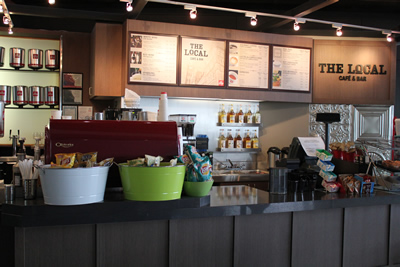
Booster Juice closed their domestic holdroom outlet in the fall for a major refresh. They reopened on December 23, and not only got back to the business of providing our customers with smoothies, fresh-squeezed juices, but a wider range of fresh-made panini sandwiches, quesadillas and wraps as well.
In-terminal Advertising
The Authority signed an eight-year contract with Astral Out of Home, a division of Bell Media, for the provision of indoor airport advertising. The agreement includes the conversion of the majority of the previous advertising infrastructure to digital technology, making Ottawa the first airport in Canada to have 100.0% of its permanent properties in digital format, complemented by limited static displays. The deployment project, which began in October, will continue through the first half of 2016, and will achieve the Authority’s key contract-related goals: the creation of a spectacular, unique and effective advertising network that maximizes revenue while preserving the architectural character of the terminal. Astral will also deploy its Aero TV product with English and French content on screens throughout the terminal, including local CTV News segments.
Long-term Taxi Contract
The Authority negotiated a long-term contract with Coventry Connections for taxi brokerage services at the airport. Revenue generation has been brought in line with industry standards and stabilized through a five-year agreement, achieving one of the primary goals of the contract. Although we faced a labour disturbance during the transition period, taxi availability and customer service levels have since been elevated and continue to improve. While the taxi industry continues to evolve, over 400,000 taxi trips originated at YOW in 2015, and the service continues to be an integral part of the airport’s customer transportation service offering.
Parking Revenue Growth
During the second year of our on-line parking offering, sales grew by an impressive 60.0% over 2014 figures, and were 37.0% ahead of 2015 projections. The Authority integrated the Chauntry Parkspace system with the Authority’s mobile application, FlyCANADA, incorporating features such as barcode entry. Growth in on-line purchasing was supported by a comprehensive digital marketing campaign with various call-to-action and drive-to-web incentives. Other loyalty and incentive programs such as CAA (North and East Ontario members) discounts were leveraged to further increase the online customer base and stimulate revenues.
Airport Land Development
Land development continues to be vitally important to the Authority as part of its non-aeronautical revenue generation efforts. In 2015, the Authority worked with existing land partners to process development applications and final design for an expansion of the existing Hilton Garden Inn, which added 159 guest bedrooms, the construction of a new 232-room suite hotel adjacent to the Hilton, and several smaller projects. Another major achievement during the year was the conclusion of a commercial brokerage service agreement with Colliers International, who will take the lead in marketing the Authority’s remaining development land starting in 2016.
TO INCREASE THE ECONOMIC FOOTPRINT OF THE AIRPORT WITHIN CANADA’S CAPITAL REGION
The Ottawa International Airport plays a more important role in this community than simply facilitating flight. It is also a major employer and a significant contributor to both the tax base and the quality of life in the region, as well as contributing more than $2.2 billion to the local economy each year. As we continue to grow over time, it is important that the City of Ottawa includes the airport in its development plans. As such, we continue to work closely with our municipal counterparts to ensure that we are building a world class city together.
O-Train Trillium Line Extension
The Authority and the City of Ottawa worked together on the environmental assessment project associated with the extension of the O-Train Trillium Line to the south, culminating in a completed draft Environmental Project Report. The Report includes a functional design that will be provided to the Provincial Minister of the Environment and Climate Change for review and approval.
The Authority funded half the portion of the environmental assessment that pertains to an essential airport link, and which includes two proposed stations on airport land. The detailed design work for the airport-rail-link started in 2015 and will continue throughout 2016. The business case for the Stage 2 rail project was completed during the year and remains strong when the airport link ridership figures are included. Confirming funding for the airport link will be an important goal in 2016.
Linking the O-Train to the airport is important for a variety of reasons. First, it will ensure efficient and reliable access to the airport and anywhere along the Confederation Line, including downtown, for residents, tourists, business visitors and employees. Second, it will become a selling point for conferences and exhibitions in our city and will facilitate transit-oriented commercial development in and around airport land.
Airport Parkway Widening
The Authority continued to participate in the City of Ottawa’s environmental assessment project for the widening of the Airport Parkway. As the primary gateway between the airport and the city centre, ensuring long term efficient access, improved capacity, and reduced travel times are critical. Congestion is becoming more commonplace on the Airport Parkway as commuter traffic from neighbourhoods located south of the airport grows.
A preliminary design for the widening of the Airport Parkway and Lester Road, developed and presented to the public at an open house event, contained proposed timing for the implementation of the project which would have seen the first phase between Brookfield and Hunt Club completed by 2018. However, due to lower than expected development fees collected by the City, the approved 2016 municipal budget effectively delays the project until at least 2020.
The Authority will continue to work with the City to ensure the best and most efficient multi-modal access and connectivity to the capital region.
Land Designation
The Authority participated in the working group of the 2015 Employment Land Review which will provide recommendations to City Council in 2016 and will protect a good supply of employment lands in appropriate locations in Ottawa. The project was initiated by the City of Ottawa but partially sponsored by the local development community. The Authority works closely with the City of Ottawa to ensure that airport lands have the appropriate designation to facilitate ongoing commercial development to ensure that the airport’s long-term economic contribution to the community can continue to grow.
TO OPTIMIZE OPERATIONAL PERFORMANCE, ENSURING SAFE AND SECURE OPERATIONS
Operations and Information Technology
Keeping step with evolving operational requirements, technological change and new regulation requires efficiency and experience. The Authority’s Terminal Operations and Information Technology teams have been working on several complex projects that involve running duplicate systems, construction in constricted spaces and working with partners that share a commitment to the same high standards as the Authority. The following are a few of the key projects which occurred during the year:
Baggage Handling System
The Authority continued with the major upgrade of our Baggage Handling System (BHS). This $60.0 million project, being completed jointly with CATSA, commenced in late 2013. In March, the new transborder baggage system went live complete with self-bag drop stations, new screening equipment and upgrades to meet the requirements of U.S. Customs and Border Protection (U.S. CBP). The new system doubles the previous capacity and has the benefit of no longer requiring the passenger to wait with their bag while it is being screened.
A new inbound baggage carousel was also added to the domestic arrivals hall in late 2015. This additional capacity should help to reduce congestion around the carousels at peak times as well as help improve baggage delivery times.
Work continues behind the scenes on a new domestic/international baggage system. Construction is now substantially complete and commissioning and testing is underway on the final stage of the work. By year end, all passenger baggage was running through the new system, including all new screening equipment. This new system, which will roughly double previous capacity, was completed with little operational impact.
Cobus

Irregular operations, airside incidents, inclement weather events or excessive diversions can put pressure on airport operations and cause issues with gate capacity and passenger movement. Rather than relying on third party assistance in these instances, the Authority researched and ultimately acquired two fully refurbished buses from Cobus, a leading airport supplier. The buses, which can transport up to 110 people each, will be used during irregular operations to provide shelter or move passengers from the airfield to the terminal, and to facilitate regular operations if remote gating becomes a requirement in the future.
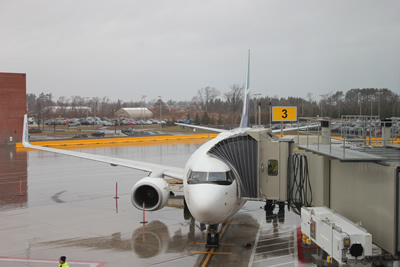
Passenger Bridge Replacement
To improve customer service and to add capacity, the Authority made modifications to Gate 3 in transborder, including the replacement of the boarding bridge. These modifications now allow larger aircraft to use this position. The existing boarding bridge was relocated to Gate 1, which previously served as a ground loading gate only. Plans in 2016 include similar modifications for Gate 6.
Automated Passport Control
Automated Passport Control (APC) is a U.S. CBP program that expedites entry for U.S., Canadian and eligible Visa Waiver Program international travellers by providing an automated process through U.S. CBP’s primary inspection area. Travellers use self-service kiosks to submit their customs declaration form and biographic information. APC is an important initiative because it contributes to shorter wait times, less congestion and faster passenger processing.
The Airport Authority and U.S. CBP collaborated through the better part of the year towards a pilot program that would locate APC capability in Authority-managed common use check-in kiosks outside of the U.S. CBP federal inspection area, unlike other airports where the kiosks are within the U.S. CBP-controlled area. Approval to pursue the pilot program was received and both organizations will continue to work together towards implementation of this exciting “first”, which could offer our customers a “one-stop-shop” for check-in and paperwork completion. The Authority’s ultimate goal with this project would be to improve processing efficiencies to the point where additional flights to the U.S. could be accommodated during peak periods.
Customer Transportation and Parking Services Enhancements
The Customer Transportation and Parking Services (CTPS) team developed several enhancements to its service offering in 2015.
The Authority launched a pilot project to determine the need for a cell phone parking lot. After deeming the pilot a success, a new permanent location was chosen and officially opened in December. With the relocation, the Long Term parking lot site of the pilot project regained 50 spaces to its capacity, just in time for the holiday rush. The new location is more readily accessible, highly visible and more suitable for increased volumes. Further customer service enhancements will include new signage, lighting, surveillance, fence removal, and landscaping. By providing waiting traffic with a free and dedicated area, the Authority will be able to reduce congestion in front of the main terminal and make picking up and dropping off passengers safer and hassle free.
The Authority added restricted access gates to the commercial curb roadway entrance in February 2015. This advancement now allows the Authority to restrict access to only those commercial vehicles that are licensed and permitted to operate at the airport. Additionally, valuable volume data is available from the system and we achieved full automation of account management and financial administration that ensures more accurate billing information is received. Through compliance assurance and the streamlining of price structures, ground transportation revenue grew by 20.0% (exclusive of taxi increases).
Through the implementation of new iPass management software, the CTPS team is now administering all aspects of the airport’s parking and commercial transportation services. All BizPark clients have been transitioned to the new system which replaced transponders with access cards, which are more reliable and not dependent on battery power. The system also ensures more accurate and timely billing for all clients. Full payment, invoicing and account management automation has been achieved, not only improving the customers experience but dramatically reducing the administration time involved.
After much customer feedback regarding the outdoor taxi queuing area that offered minimal protection from the elements, the team worked with partner, WSP, to design and implement a new concept that provides a more comfortable waiting area, facilitates a more efficient queuing system and blends more attractively with the terminal architecture.
Safety
Ottawa Airport continues to lead the way in safety through all aspects of its operation.
Runway Safety
The International Civil Aviation Organization (ICAO) is currently working towards a Takeoff and Landing Performance Assessment (TALPA) methodology for runway condition reporting. This would standardize terms and definitions used to describe a contaminated runway internationally. In the United States, the Federal Aviation Administration (FAA) TALPA program is using recommendations from their Aviation Rulemaking Committee (ARC) and will be adopting a runway condition assessment matrix based on runway conditions assessed by the airport operator. As the aviation industry moves towards a globally harmonized method for reporting runway conditions and as the carriers that use our airport start to adopt these new standards, the Authority has responded by refining snow clearing methods to ensure that the highest possible conditions are maintained. In addition, we continue to grow our winter fleet with the addition of two new snow blowers, one new runway de-icing truck and a large combination plow/sweeper. The Authority also increased storage capacity for runway de-icer with the construction of a new 400 square metre storage facility.
Following on the reconstruction of our three major runways, including the addition of ICAO-rated runway end safety areas and grooving of the two commercial runways, as well as the renewal of the de-icing pad, all of which were completed over the last four summers, we are now in a maintenance cycle. In 2015, the Authority rebuilt the main apron area just south of the de-icing pad at a cost of $3.5 million. This area is used as both a taxiway area to and from the de-icing pad as well as for occasional aircraft parking.
Bird Mitigation
Bird strikes are an ongoing safety concern at all airports and are addressed in YOW’s Wildlife Management Plan (AWMP). The Canada Goose is a high priority species because of its potential to cause catastrophic damage to aircraft. The airport’s proximity to the Rideau River poses a unique safety challenge, which was tested in the fall when a flock of approximately 10,000 geese roosted in an area of the river directly to the west of the airport. Adding to the risk, the flock would overfly the airport twice per day as it travelled to its feeding area east of the airport, at an elevation of between 200 and 800 feet.
As a means of mitigating the risk, the Authority engaged Predator Bird Services which employed a variety of non-lethal means to disturb the roost and move the flock to a more favorable location. The work was successfully completed with the support of Parks Canada, Environment Canada, the Ministry of Natural Resources and the City of Ottawa. The move was also highly supported by the aviation community, and particularly the Air Canada Pilots Association which cited the activity as “an excellent example of identifying an aviation hazard and implementing an effective method of mitigating risk”.
Searidge Technologies Partnership
The Authority entered a strategic partnership agreement with Ottawa firm, Searidge Technologies, to integrate all information sources including real-time surface management data, air traffic control data and the airport’s proprietary data, into a single user interface in the Airport Operations Coordination Centre (AOCC). The solution will offer the Authority more effective management of ground traffic, improved traffic flow, increased situational awareness and reduced need for communication, and will offer Searidge the opportunity to showcase the benefits of its integrated approach to other airports around the world.
Secure Operations
2015 saw many changes to the security portfolio, along with new and innovative programs that are piquing the interest of other airports and our regulator, Transport Canada, as we take a leadership position and share our knowledge with other airports.
Airport Security Program
The Authority continued with the implementation of Transport Canada’s Airport Security Program (ASP) requirements. These have included non-passenger vehicle screening points, designated airport security officials, enhanced emergency management plans, security training programs and threat risk vulnerability programs. Significant progress was made on all of these projects during the year. The Authority continues to make customer security and safety the highest priority by not only meeting all of the ASP requirements ahead of schedule, but by focusing on being aviation security industry leaders by exceeding standards, maximizing expertise, technology and resources, while also providing enhanced security capabilities not seen in other airports. Becoming an industry leader has given the Authority the ability to adapt to a changing threat environment and to identify flexible alternatives to respond to rapid changes.
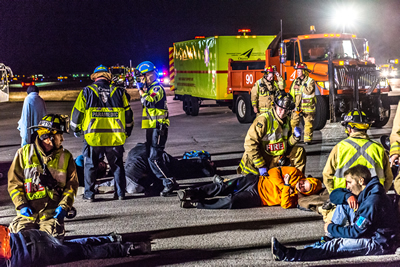
Exercise Predator
On October 27, the Authority hosted a major safety exercise to test its emergency response plan. The scenario involved a strike by an unmanned aerial vehicle (UAV or drone), which damaged an aircraft that was on final descent and caused it to crash on the airfield, resulting in significant loss of life and injuries.
Authority staff worked with the Ottawa Police Service, Ottawa Paramedic Service, Ottawa Fire Services, Air Canada, and students from Algonquin College, MedVent and La Cité, in all 220 people, to make the exercise a success. The exercise offered each participating agency an opportunity to test various components of their internal Standard Operations Procedures (SOPs) and how they can be applied to an overall large scale response at an airport. Other areas of interest included public safety, coordination among responders, passenger care, airfield operations and health and medical. Transport Canada mandates that major airports in this country must conduct operations-based safety exercises every two years to test and validate their emergency plans.
Airport Emergency Management Training Program
Continuing the themes of leadership and innovation in security planning, the Authority’s Security and Emergency Management Team developed an Emergency Management Training Program to implement a standardized, airport-specific system for Security and Emergency Management employees who are responsible for the response and recovery to incidents/emergencies. It is also designed to support airport stakeholders (i.e. tenants, airlines), aviation sectors of government and first responders who may be required to support YOW security/emergency operations. The Program includes the Airport Basic Emergency Management (ABEM) course, Airport Incident Management System (AIMS) course, Behavioral Analysis course, canine workshops and enhanced Red Team testing, tabletop and real-time exercises. The courses and training have helped the airport meet its goal of providing a consistent framework to any potential threat/risk that may affect the delivery of airport operations while including various stakeholders.
Financial
Ensuring that the operation is financially viable and fiscally responsible are also priorities for the Authority, and as such, we take a very measured approach to spending and fee-setting.
The Financial Year at a Glance
The Authority maintained a strong financial position in 2015. Revenue drivers continued to show variability during the year while revenues reached record levels. Despite modest passenger volume growth of 0.9% in 2015, our seat volumes declined 0.5% in 2015 as compared to 2014. While domestic seat volumes grew 0.3%, U.S. and international volumes declined with contributing factors including higher rates of cancellations of inbound flights from other North American airports due to the worse than normal winter weather conditions in the first quarter of 2015 and a later start to the winter charter season in late 2015. Furthermore, volumes were impacted by the global airline trend of operating fewer flights with higher load factors (seat occupancy) demonstrated by the rationalization of multiple departures to the same destination and the impact of the consolidation of U.S.-based air carriers as evidenced by the cancellation of the Charlotte, North Carolina flight due to the American Airlines and US Airways merger. Total revenues in 2015 were 5.3% higher at $118.3 million compared to $112.3 million in 2014. Modest passenger volume growth and the year over year residual impact of the March 2014 increase in AIF rates from $20 to $23 drove higher AIF revenues. Additionally, increases in aeronautical revenues resulting mostly from increases in tariffs early in 2015, favorable impacts from higher passenger volumes, and revenue optimization activities on non-aeronautical sources including ground transportation, car rental and other concessions, added to the higher figures.
The Authority also completed a $300.0 million Series E Bond issue on June 9, 2015, to take advantage of the low interest rate environment and secure favorable terms in its long-term financing strategy. The net proceeds from this offering were used to pre-fund the 2017 repayment of the Series D Bonds by depositing $200.0 milion into a segregated fund, to refinance existing bank indebtedness incurred by the Authority in connection with its capital expenditure programs, and to use for future general corporate and capital expenditures. The Authority finished 2015 by generating earnings before depreciation of $27.8 million compared to $29.2 million for the year ended December 31, 2014. The Authority anticipated the year over year reduction due to the incremental interest impact from the Series E Bond. These earnings will be reinvested in airport operations and development.
PCI-DSS Compliance
Thousands of credit card transactions with the Authority and its customers are completed each day at the airport and the Authority needs to ensure the integrity and transparency of each transaction so as to optimize revenues while ensuring data security and safety. Because it is critical that we provide a safe and secure environment for these transactions, the Authority embarked in recent years on a process for compliance with Payment Card Industry Data Security Standard (PCI DSS) requirements. In 2015, the Authority undertook an audit of the PCI DSS compliance processes as a merchant and received a positive low risk rating. The rating reinforced the strict policies the Authority put in place to ensure that all people, processes and technology involved in acceptance, storage, processing and transmission of credit card data are in compliance with PCI DSS standards.
TO PURSUE EXCELLENCE
The Authority’s commitment to excellence takes on many forms. We monitor, correct and measure, and then audit to ensure that we are providing our customers with the best possible experience each time they visit. This commitment to excellence is campus-wide, and is evident in areas that the Authority has direct responsibility for, as well as those we do not. The pursuit involved many areas of the operation in 2015, including the following:
Airport Service Quality Program – A Sterling Finish
The Authority was very pleased to finish in 2nd place in North America in the ASQ program, marking a return to the podium. We are also very pleased that we improved our overall customer satisfaction score compared to 2014 and posted higher scores in the following categories:
- Wait time at passport/ID/security inspection
- Shopping facilities and value for money
- Internet/Wi-Fi service
- Courtesy/helpfulness of staff
These results are thanks to a campus-wide commitment to providing a great customer experience, and we are grateful to our partners for going above and beyond to delight our passengers. A big thank you as well to our cherished clients who took the time to complete the survey and show their appreciation for the airport.
National Capital Region’s Top Employer (2015) – Third Consecutive Year!
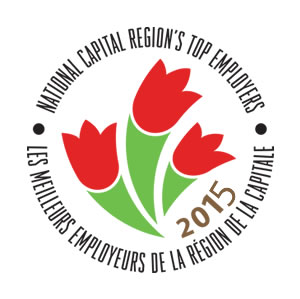
Excellence in any organization starts with the team, and the Authority is fortunate to have a talented and engaged workforce that demonstrates its commitment to excellence in every aspect of airport operations each day. That level of dedication makes the Authority’s selection as one of the National Capital Region’s Top Employers, for the third consecutive year, an even greater source of pride for every member of the Authority family.
The National Capital Region’s Top Employers is an annual competition organized by the editors of Canada’s Top 100 Employers. This special designation recognizes the Ottawa-area employers that lead their industries in offering exceptional places to work.
Canadian Association of Chiefs of Police (CACP) Motorola Award for Excellence in Emergency Preparedness
The CACP/Motorola Award for Excellence in Emergency Preparedness has been established to recognize a standard of excellence that reflects the combined efforts of police, fire, and emergency medical services in preparing their agencies to respond to disasters.
Exercise Silver, which we told you about in 2014, was a full scale, active shooter exercise designed and conducted inside the airport involving 266 people including the Authority, Ottawa Police Service, Ottawa Paramedic Service, Ottawa Fire Services, Air Canada, role players and various observers. The Ottawa Airport became one of the first airports in the world to develop and conduct an active shooter program/exercise. The Authority subsequently produced an Active Shooter Training video that has been requested by airports and law enforcement agencies across North America.
We were very proud to have received the CACP Motorola Award in recognition of the innovation, complexity, and success of Exercise Silver.
Social Media Engagement
After acquiring a new canine trainee in the Authority’s canine program, the Communications Team worked with the Canine Unit to help name the new puppy. Photos of the pup were posted on Twitter and Facebook with a call for suggestions to help “Name Our Dog”. We were quickly overwhelmed with the response received through both social media channels and via email. The Facebook post itself had a reach of more than 61,000, thanks to The Ottawa Citizen writing about it and promoting the contest. In all, more than 1,300 entries were received, from which a small team from both departments chose their short list. In the end, we unanimously settled on the name “Jet”.
Social Media Success

Airports Council International-North America (ACI-NA) held its 2015 Excellence in Airport Marketing, Communications and Customer Service Awards ceremony at its annual conference in Nashville, Tennessee. We submitted the “Name Our Dog” contest for consideration in the social media campaign category, and were thrilled that it won 1st place. Our goal with the social media campaign was to increase awareness about our Canine Unit. Considering the number of people who participated in this contest, the local news coverage, and the award, the goal was achieved.
Infoguide Volunteers
Excellence in customer service is a team effort at the airport, and our corps of 80+ Infoguide volunteers are very important to the team. From answering tens of thousands of calls each year and helping track down lost baggage, to reuniting loved ones and finding hotel rooms for stranded passengers, each volunteer provides service with a welcome smile and an empathetic demeanor. In 2015, they volunteered nearly 7,500 hours representing Ottawa-Gatineau with pride. The entire campus is grateful for their efforts.

Infoguide Milestone
One Infoguide volunteer, in particular, reached an unprecedented milestone in her service to the airport. Gladys Pfeffer was the first ever volunteer to reach 25 years of service. She started volunteering in the original terminal when the program was called Traveller’s Aid, and in recent memory has filled a regular Friday afternoon shift, now in Arrivals.Thank you Gladys!
TO PROVIDE ADDITIONAL FLIGHT FREQUENCIES AND DESTINATIONS
To quote a recent article in the Ottawa Business Journal, “passenger planes don’t just fly anywhere”. All airlines need a compelling business case to serve a market, and key to the case is profitability. The focus on air service strategy and development is an ongoing priority for the Authority, as is the work with our partners in the tourism and convention industry to stimulate demand in our region.
Air Service Development Activities
Travel to sunshine destinations continues to be one of the biggest growth areas in our market. Air Canada added weekly summer service to Orlando, Florida, as well as non-stop service to Cayo Coco and Holguín, both in Cuba, for the 2015/2016 winter season. They also announced that non-stop service to Samana in the Dominican Republic would start in January 2016.
WestJet boosted their daily summer service to Halifax to annual service and an additional frequency was added to the daily flight for the summer season. They also added daily service to Moncton.
Other service to the sun destinations included Sunwing weekly summer service to Varadero, Cuba and Air Transat seasonal winter service to Orlando.
The merger of American Airlines and US Airways resulted in the elimination of daily service to Charlotte, North Carolina. Air Transat’s weekly summer service to London-Gatwick, and Air Canada’s winter service to Providenciales in Turks and Caicos also ended in 2015.
Where Do You Want To Fly?
The Authority wishes to make sure that business cases for air service reflect the needs of our client base. While we can not guarantee a requested route will materialize, it is important that we provide accurate information and statistics to airlines so that they can make important aircraft deployment decisions. To get that information, we embarked on a corporate travel survey, in partnership with InterVISTAS Consulting, to learn about the travel needs and patterns of local businesses. The survey was promoted in media articles late in 2015, and will officially launch in the first quarter of 2016.
STRATEGIC INITIATIVES
The Authority’s Strategic Plan was collaboratively developed with the Board of Directors and Senior Management Team, and is based on five key Strategic Directions. The following identifies the initiatives within each Direction across the 2016-2020 timeline:
1. To grow strategically
- to grow non-aeronautical revenues
- to provide passengers and commercial airlines with world class airport facilities
2. To increase the economic footprint of the airport within Canada’s Capital Region
- to increase the economic impact of the airport by generating employment and economic activity on airport land
- ensure efficient transportation access to the airport through continued advocacy with the City of Ottawa concerning a Light Rail Transit (LRT) airport link
3. To optimize operational performance, ensuring safe and secure operations
- to be recognized for strong financial management practices and strong financial performance among airports in Canada
- to show continued leadership in airport safety and security
- to show continued leadership in sustainable airport management and environmental practice
4. To pursue excellence
- to continue to achieve consistently high customer satisfaction
- to ensure excellence in employee engagement
- to demonstrate leadership in corporate governance
5. To provide additional flight frequencies and destinations
- to increase flight options through the implementation of an effective air service development strategy
- to support tourism, business and convention development in Ottawa by stimulating demand for air travel







